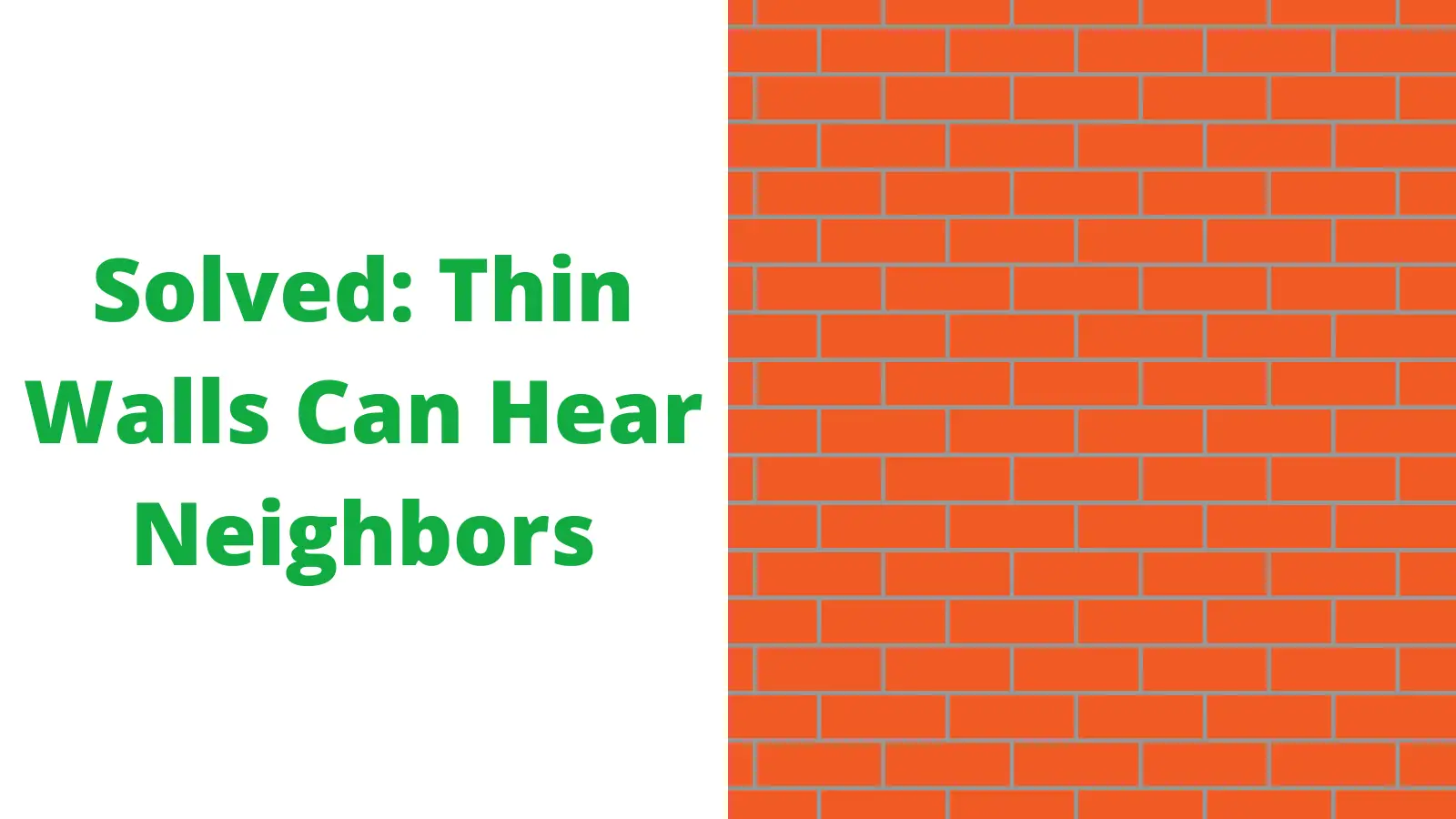Solved: Thin Walls Can Hear Neighbors
If your house has thin walls you can hear your neighbors down the block, you aren’t alone.
I remember in my 20s when I lived in this terrace house as a student, and I could hear everything my neighbors did. Sometimes it was so loud that you felt like the neighbors were actually in the house.
One day I had a friend over, and he joked how he could hear the guy three doors down breathing. While it was funny, it wasn’t healthy at all, as in most cases, I couldn’t get anything done.

Over the years, I’ve lived in all manner of houses, and one of the primary determinants of noise from the neighbors getting into your house is the quality of construction.
If the house is well constructed, you will rarely hear any noise, but if the construction is poor, you will be in for a time of your life.
If your house has thin walls, it’s poorly constructed, so the die is already cast against you.
What does this mean? Should you move?
Well, if you are like me and don’t like noise distractions, move to a better-constructed building.
As you are planning the big move, you should note that the better-constructed building is most likely new, and due to the high amount of money, that the property owner spent putting it up, the rent is up there.
A quieter house is also most likely out of the town center, meaning that you will have a longer commute.
If you are ready for the change and have money to pay for the new, better-constructed house, make a move.
But if the noise isn’t too much, you don’t have money for a new apartment, or you don’t want the inconvenience that will come with the change, come up with ways to reduce the noise coming through the thin walls.
How to reduce noise through walls
Luckily, there are many ways to reduce noise from getting through the thin walls. These ways include:
Fill all the holes and gaps in the house
This is one of the easiest and often highly effective ways to block noise. Filling the holes and gaps is also a great option when you can’t change your wall as a tenant.
Carefully go through the entire house and identify any holes and gaps that might be present on the walls, windows, ceiling, and even the door. You should then carefully seal these gaps with Green Blue noise-proofing sealant.
The beauty of this sealant is that it’s specially designed to provide a top-notch seal that keeps out most of the noise. The sealant is pliable, so it doesn’t crack when it dries up or ages.
As you are sealing the gaps in the house, don’t forget the electrical connections such as sockets, as they might bring in substantial amounts of noise. To ensure that your house is noise-proof, remove these connections and carefully apply the sealant in all the gaps present.
Add another drywall layer.
If your landlord allows you to alter your drywall, you can apply second drywall to keep out as much noise as possible.
To get the most from the drywall, don’t use the same drywall already in place—use a different one (a thicker layer is better). For example, if you already have a 1/8” thick layer, install a ¼” layer.
You also should be cautious about how you install the drywall sheet. For the best outcome, apply the GreenGlue soundproofing compound at the back of the sheet before placing it on top of the existing drywall.
The soundproofing compound isn’t glue, but a compound that absorbs sounds, preventing them from passing the wall and getting to you.
Use mass-loaded vinyl.
Mass-loaded vinyl comes in a 4 feet long roll that is usually thin, but highly dense, so it works like magic at keeping out noises.
If you can’t alter your walls, place the vinyl roll outside your walls. If you can alter your walls, place the vinyl between the drywall layers, and you will experience a substantial change in the amount of noise coming into the house.
Besides the vinyl keeping out the noise, it also insulates the apartment and keeps you cozy.
Use a resilient channel.
Resilient channels are often used in ceilings where they are used to reduce stomping and other noises coming from an upstairs neighbor, but you can always use them to improve the soundproofing capabilities of your thin walls.
Remove your drywall and apply sound clips besides the joists and studs to achieve the desired effects. You should then screw the channels in the clips using drywall screws.
As you are screwing, ensure that the screws stay within the channel’s web and don’t contact the resilient channel base support.
Also, don’t over-tighten the screws as they can tear inside the metal channel.
Once the channels are in place, place the second layer of drywall and tighten it in place using proper, longer screws.
Paint the house with sound dampening paint
Can’t add another layer of drywall? No problem. You can use sound dampening paint.
This is paint that is specially designed to reduce the noise getting through the wall by a few decibels. For the best outcome, buy the right sound dampening paint. Also, apply at least three coats of paint.
Add bookshelves
Books add mass, which comes in handy at reducing the noise coming into the house. All you need to do is work with your contractor and build shelves on the thin walls. You should then fill the walls with books.
If you don’t have enough books, install cover doors to keep the shelves closed, keeping out even more noise.
The beauty of shelves is that they not only keep out noise, but also add to your storage space, so you have a place to store the many things lying around your house.
Use moving blankets
These are made from dense materials, which keep out noise. If there isn’t much noise coming in, you can block it using one or two moving blankets, but if the noise is substantial, you may have to sew together three or more moving blankets.
While the blankets are effective, they don’t keep out loud noises. Get soundproofing blankets if your neighbors are making a lot of noise, and you can’t alter your drywall.
These soundproof doors, so they come in smaller. This means that they can be pricey, especially if you have to soundproof for the entire house.
The beauty is that they keep out most noises, so you enjoy the serenity you are craving.
Other ways to soundproof your thin walls
Stack furniture against the wall: This one works the same way as bookshelves, where it increases the mass on the wall, hence reducing the noise coming in.
Stack big pieces of furniture such as wardrobes against the thin wall to add mass and keep out the noise from the neighbors.
Add some artwork on your walls: They also add mass and keep out the noise. When hanging the artwork, ensure that it’s beautiful so that you don’t spoil the ambiance in your apartment in the name of soundproofing.
Put tapestries on your wall: Tapestries are made from fabric, so when properly placed on the wall, they can stop the sounds from your neighbors. When shopping for tapestries, find those that complement your sense of style.
Use thick wallpaper: When properly installed, thick wallpaper can also keep out the sounds from your neighbors. Again, ensure the wallpaper you use fits into your style.



